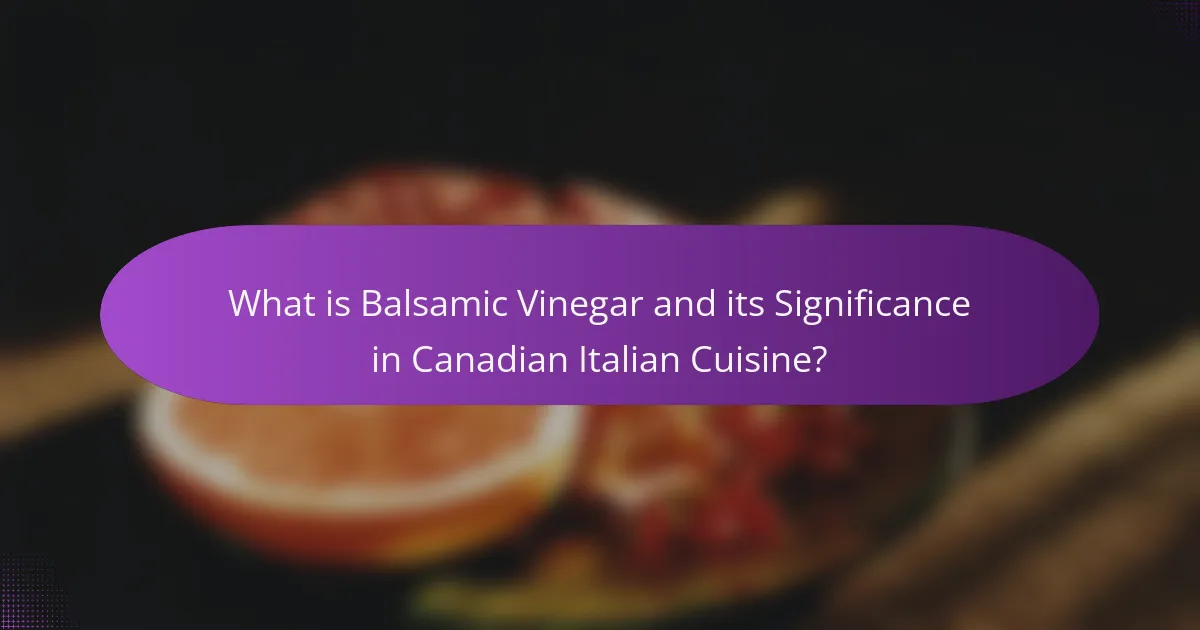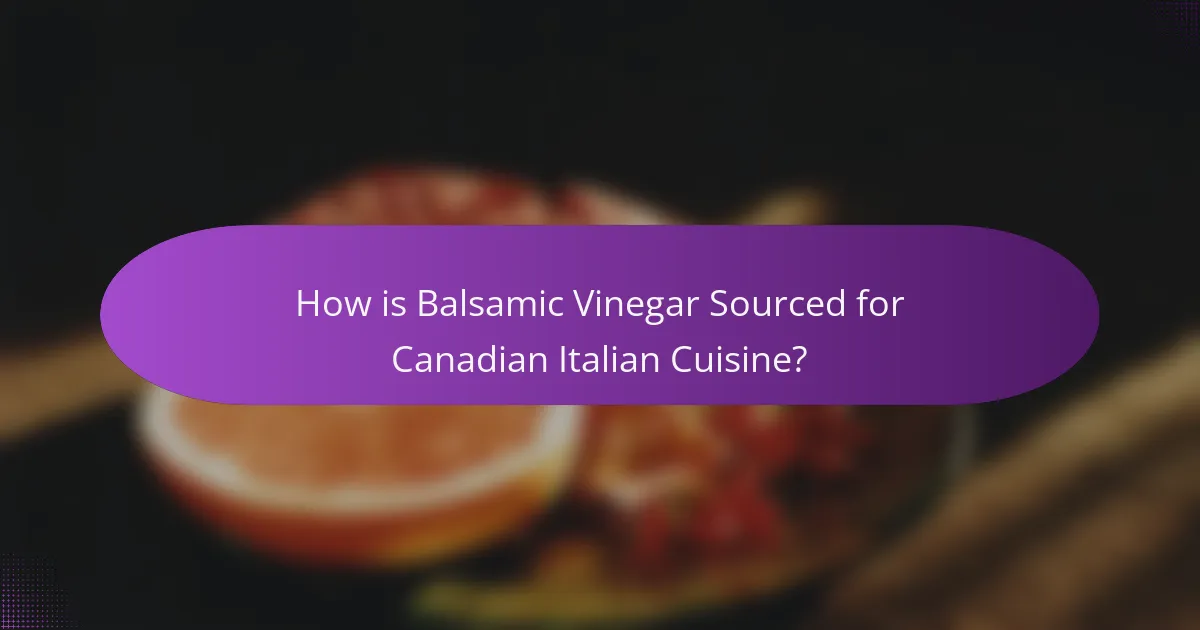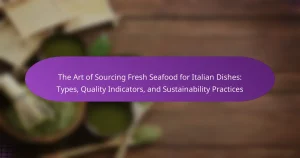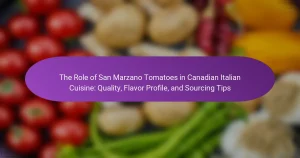
What is Balsamic Vinegar and its Significance in Canadian Italian Cuisine?
Balsamic vinegar is a dark, flavorful vinegar originating from Modena, Italy. It is made from freshly crushed grape must, which is cooked down and aged in wooden barrels. This aging process can take several years, resulting in a complex flavor profile. In Canadian Italian cuisine, balsamic vinegar is significant for its versatility. It enhances salads, marinades, and glazes. Its sweet and tangy notes complement various dishes. Many Canadian Italian restaurants feature balsamic vinegar as a key ingredient. This ingredient reflects the Italian heritage of many Canadians. The use of balsamic vinegar in Canada showcases the fusion of traditional and modern culinary practices.
How is Balsamic Vinegar Made?
Balsamic vinegar is made through a process of fermentation and aging. The primary ingredient is grape must, which is freshly crushed grape juice, including seeds and skins. This grape must is cooked down to concentrate its sugars. The cooked must is then fermented with the help of natural yeasts. After fermentation, the vinegar is aged in wooden barrels, which imparts unique flavors. The aging process can last from several months to several years. Traditional balsamic vinegar requires a minimum aging of 12 years. The longer the vinegar ages, the more complex its flavor becomes. This meticulous process is what distinguishes high-quality balsamic vinegar from others.
What are the key ingredients in Balsamic Vinegar?
Balsamic vinegar primarily consists of grape must and wine vinegar. Grape must is made from freshly crushed grapes, including the skins, seeds, and stems. This mixture is cooked down to create a concentrated syrup. Wine vinegar is produced through the fermentation of wine, which contributes to the vinegar’s acidity. The combination of these two ingredients gives balsamic vinegar its unique flavor profile. Authentic balsamic vinegar is aged for a minimum of 12 years, enhancing its complexity and sweetness. The quality of the grapes and the aging process are crucial for determining the final product’s flavor and aroma.
What processes are involved in the production of Balsamic Vinegar?
Balsamic vinegar production involves several key processes. The first step is harvesting ripe grapes, typically Trebbiano or Lambrusco. The grapes are then crushed to extract the juice. Next, the juice is cooked down over low heat to concentrate its sugars. This cooked must is fermented using natural yeasts. After fermentation, the vinegar undergoes aging in wooden barrels, which imparts unique flavors. The aging process can last from several months to several years. Finally, the vinegar is filtered and bottled for sale. This method ensures a rich, complex flavor profile characteristic of authentic balsamic vinegar.
What Types of Balsamic Vinegar are Commonly Used?
Traditional Balsamic Vinegar and Commercial Balsamic Vinegar are the two commonly used types. Traditional Balsamic Vinegar originates from Modena, Italy. It is made from freshly crushed grape must and aged for a minimum of 12 years. This type has a rich, complex flavor profile. Commercial Balsamic Vinegar is produced more quickly. It often contains added sugars and flavorings. This type is widely available in grocery stores. It is less expensive than traditional balsamic vinegar. Both types are used in various culinary applications, enhancing dishes with their unique flavors.
What distinguishes Traditional Balsamic Vinegar from Commercial Balsamic Vinegar?
Traditional Balsamic Vinegar is made using a lengthy aging process, often lasting several decades. This process involves cooking grape must and fermenting it in wooden barrels. The result is a complex flavor profile with a thick, syrupy consistency. In contrast, Commercial Balsamic Vinegar is typically produced quickly using wine vinegar and additives. It often lacks the depth of flavor and richness found in traditional varieties. Furthermore, Traditional Balsamic Vinegar is protected by a PDO (Protected Designation of Origin) status in Italy. This ensures authenticity and adherence to strict production methods. Commercial varieties do not have such regulations, leading to significant quality differences.
How do different aging processes affect the flavor of Balsamic Vinegar?
Different aging processes significantly affect the flavor of Balsamic Vinegar. Longer aging in wooden barrels enhances complexity and depth. This process allows for the development of rich, sweet notes and a thicker consistency. Shorter aging results in a sharper, more acidic flavor profile. The type of wood used also influences flavor; for example, oak imparts vanilla and spice notes. Traditional balsamic vinegar undergoes a lengthy aging process, often exceeding 12 years, leading to a smoother finish. In contrast, commercial varieties may age for only a few months, resulting in a less refined taste. The interaction between the vinegar and barrel wood is crucial for flavor development.
What Flavor Enhancements Does Balsamic Vinegar Bring to Dishes?
Balsamic vinegar enhances dishes by adding a rich, sweet, and tangy flavor profile. Its complexity can elevate salads, marinades, and glazes. The acidity balances richness in fatty foods like meats. It also brings depth to sauces and dressings. Balsamic vinegar can intensify the flavor of roasted vegetables. Its natural sweetness complements fruits and desserts. The unique aging process contributes to its distinct taste. This versatility makes it a staple in various cuisines.
How can Balsamic Vinegar be paired with various ingredients?
Balsamic vinegar pairs well with a variety of ingredients. It complements fruits like strawberries and peaches, enhancing their natural sweetness. It also works well with cheeses, particularly aged cheeses like Parmigiano-Reggiano. Drizzling balsamic vinegar over salads adds depth and acidity. It can be used in marinades for meats, especially chicken and pork, to tenderize and flavor. Balsamic vinegar enhances roasted vegetables, bringing out their caramelized flavors. Additionally, it can be combined with olive oil for dipping bread. These pairings highlight the versatility of balsamic vinegar in enhancing dishes.
What are some popular recipes that highlight Balsamic Vinegar?
Caprese salad is a popular recipe that highlights balsamic vinegar. It combines fresh mozzarella, tomatoes, and basil, drizzled with balsamic vinegar. Balsamic-glazed Brussels sprouts are another favorite. They are roasted and tossed with balsamic vinegar for added flavor. Grilled chicken with balsamic reduction enhances the meat’s taste. The reduction is made by simmering balsamic vinegar until thickened. Balsamic vinegar is also used in marinades for vegetables and meats. It adds depth and sweetness to the dishes. Lastly, balsamic vinegar is a key ingredient in fruit salads. It complements strawberries and peaches beautifully. These recipes showcase the versatility of balsamic vinegar in cooking.

How is Balsamic Vinegar Sourced for Canadian Italian Cuisine?
Balsamic vinegar is sourced primarily from Modena, Italy, where it is traditionally produced. The production involves using freshly crushed grape must, which is then cooked down and aged in wooden barrels. Authentic balsamic vinegar undergoes a lengthy aging process, often lasting several years. This aging develops its complex flavors and aromas. In Canada, many chefs seek imported balsamic vinegar from reputable producers in Modena. They often verify authenticity through labels indicating “Aceto Balsamico Tradizionale di Modena.” Local Canadian suppliers may also offer balsamic vinegar, but the quality and authenticity can vary. Chefs and consumers prioritize sourcing high-quality balsamic vinegar for its rich flavor profile in Italian dishes.
What Should You Look for When Buying Balsamic Vinegar?
When buying balsamic vinegar, look for authenticity and quality indicators. Authentic balsamic vinegar is labeled as “Aceto Balsamico Tradizionale.” Check for a D.O.P. (Denominazione di Origine Protetta) seal, which guarantees its origin from Modena or Reggio Emilia in Italy. The ingredient list should be simple, ideally containing only grape must and vinegar. A thicker consistency often indicates higher quality. Aged balsamic vinegar typically has a richer flavor and complexity. Avoid products with added caramel color or artificial flavors. Additionally, consider the price; high-quality balsamic vinegar often comes at a premium.
What labels or certifications indicate quality Balsamic Vinegar?
Quality Balsamic Vinegar is indicated by specific labels and certifications. The most recognized certification is the Protected Designation of Origin (PDO) in Europe. This label ensures that the vinegar is produced in specific regions using traditional methods. Another important label is the IGP (Indicazione Geografica Protetta), which signifies geographical authenticity. Authentic Balsamic Vinegar di Modena will often display the “Aceto Balsamico Tradizionale” label. This label guarantees adherence to strict production standards. Additionally, look for certifications from reputable quality control organizations. These certifications often indicate adherence to high-quality production practices.
How can you identify authentic Balsamic Vinegar in stores?
Authentic Balsamic Vinegar can be identified by checking for specific labels and certifications. Look for “Aceto Balsamico Tradizionale di Modena” on the bottle. This label indicates it meets strict production standards. The vinegar should also have a thick consistency and a complex flavor profile. Authentic varieties are aged for a minimum of 12 years. The price is typically higher than non-authentic options, reflecting the quality. Additionally, check for the presence of a DOP (Denominazione di Origine Protetta) seal. This seal guarantees that the vinegar is produced in a specific region of Italy under regulated conditions.
Where Can You Find High-Quality Balsamic Vinegar in Canada?
High-quality balsamic vinegar can be found at specialty food stores, gourmet shops, and online retailers in Canada. Stores like Whole Foods and Italian markets often carry authentic options. Online platforms such as Amazon and specialty websites like Olive Oil Lovers provide a wide selection. Many of these retailers source their balsamic vinegar directly from Italy, ensuring quality. Look for labels indicating “Aceto Balsamico di Modena” for authenticity. These products typically undergo strict quality control measures. Many Canadian chefs recommend these brands for their superior flavor profiles.
What are some recommended brands or producers of Balsamic Vinegar?
Recommended brands of Balsamic Vinegar include Acetaia Giusti, which is known for its high-quality traditional balsamics. Another notable producer is Colavita, recognized for its authentic Italian products. Additionally, the brand Modena offers a range of balsamic vinegars that are well-regarded. These brands have established a reputation for quality and authenticity in the balsamic vinegar market.
How can local markets and specialty stores enhance your options?
Local markets and specialty stores enhance your options by offering unique and diverse products. They often stock artisanal and locally sourced balsamic vinegars not found in mainstream grocery stores. These products can include various flavor profiles and aging processes, providing a richer culinary experience. Specialty stores typically have knowledgeable staff who can offer recommendations based on your taste preferences. This personalized service helps consumers discover new flavors and uses for balsamic vinegar. Additionally, local markets frequently feature seasonal and fresh ingredients that complement balsamic vinegar, enhancing overall dish quality. Access to these unique products supports local producers and fosters community connections.

What Best Practices Should You Follow for Using Balsamic Vinegar?
Use balsamic vinegar in moderation to enhance flavors without overpowering dishes. Pair it with olive oil for salad dressings to create a balanced taste. Drizzle it over grilled vegetables or meats to add depth and sweetness. Use it as a finishing touch on dishes like risottos or pasta for a gourmet feel. Store balsamic vinegar in a cool, dark place to maintain its quality. Avoid exposure to heat and light, which can degrade its flavor. Always use a clean utensil to prevent contamination. Opt for high-quality balsamic vinegar, as it offers richer flavors and better health benefits.
How Can You Store Balsamic Vinegar Properly?
Store balsamic vinegar in a cool, dark place. A pantry or cupboard is ideal. Keep the bottle tightly sealed to prevent air exposure. Avoid direct sunlight, which can degrade the quality. Ensure the temperature remains stable, ideally between 50°F to 70°F. Refrigeration is not necessary, but it can extend freshness. Proper storage maintains flavor and quality over time. Studies show that vinegar can last indefinitely if stored correctly.
What are the ideal conditions for storing Balsamic Vinegar?
Balsamic vinegar should be stored in a cool, dark place. Ideal storage conditions include a temperature between 60°F and 70°F. Exposure to light and heat can degrade its quality. A tightly sealed bottle prevents oxidation. Glass containers are preferable for preserving flavor. Avoid storing balsamic vinegar near strong odors. This helps maintain its distinct taste. Proper storage extends its shelf life significantly.
How long does Balsamic Vinegar last once opened?
Balsamic vinegar lasts about 3 to 5 years once opened. This shelf life is due to its high acidity, which acts as a preservative. Proper storage, such as keeping it in a cool, dark place, can extend its quality. Over time, it may become thicker or change in flavor, but it remains safe to consume. The USDA states that vinegar does not spoil, making it a long-lasting pantry staple.
What Tips Can Enhance Your Culinary Experience with Balsamic Vinegar?
Use high-quality balsamic vinegar for the best flavor. Authentic balsamic vinegar has a rich, complex taste. Drizzle it over salads to enhance freshness. Pair it with fruits like strawberries or peaches for a sweet contrast. Use it as a marinade for meats to add depth. Incorporate it into sauces for a tangy kick. Experiment with reductions to create a syrupy glaze. Store it in a cool, dark place to maintain its quality.
How can you experiment with Balsamic Vinegar in your cooking?
You can experiment with Balsamic Vinegar in your cooking by using it in marinades, dressings, and glazes. Combine it with olive oil for a simple salad dressing. Drizzle it over grilled vegetables to enhance their flavor. Use it to marinate meats, which adds depth and sweetness. Incorporate it into sauces for pasta dishes to create a rich taste. Experiment with reducing Balsamic Vinegar to make a syrup for desserts. Pair it with fruits like strawberries or peaches for a unique dessert topping. These methods highlight the versatility and rich flavor profile of Balsamic Vinegar in various dishes.
What common mistakes should you avoid when using Balsamic Vinegar?
Using Balsamic vinegar incorrectly can diminish its flavor and culinary benefits. A common mistake is using low-quality balsamic vinegar instead of authentic, aged varieties. This can result in a lack of depth in flavor. Another mistake is using it in high-heat cooking, which can cause the vinegar’s complex flavors to evaporate. Additionally, overusing balsamic vinegar can overwhelm dishes, masking other ingredients. Not balancing balsamic vinegar with complementary flavors can also lead to unappetizing results. Finally, storing balsamic vinegar improperly, such as in direct sunlight or in a warm place, can degrade its quality.
Balsamic vinegar, a dark and flavorful vinegar originating from Modena, Italy, plays a significant role in Canadian Italian cuisine due to its versatility and rich flavor profile. This article explores the types of balsamic vinegar, including traditional and commercial varieties, and discusses the production processes, key ingredients, and aging methods that contribute to its unique taste. Additionally, it highlights how balsamic vinegar enhances various dishes and provides guidelines for sourcing high-quality options in Canada, ensuring authenticity and flavor integrity. The article also offers best practices for using and storing balsamic vinegar to maximize its culinary benefits.


